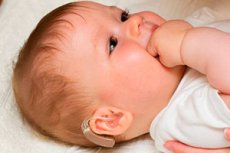Nye publikasjoner
Genterapiforsøk: Gjenoppretting av hørselen hos barn med arvelig døvhet
Sist anmeldt: 02.07.2025

Alt iLive-innhold blir gjennomgått med medisin eller faktisk kontrollert for å sikre så mye faktuell nøyaktighet som mulig.
Vi har strenge retningslinjer for innkjøp og kun kobling til anerkjente medieområder, akademiske forskningsinstitusjoner og, når det er mulig, medisinsk peer-evaluerte studier. Merk at tallene i parenteser ([1], [2], etc.) er klikkbare koblinger til disse studiene.
Hvis du føler at noe av innholdet vårt er unøyaktig, utdatert eller ellers tvilsomt, velg det og trykk Ctrl + Enter.

I en fersk studie publisert i tidsskriftet Nature Medicine evaluerte forskere sikkerheten og effekten av binaural terapi med adenoassosiert virus 1 (AAV1)-human otoferlin (hOTOF) hos fem barn med autosomal recessiv døvhet type 9 (DFNB9).
Millioner av mennesker over hele verden lider av hørselstap forårsaket av abnormiteter i OTOF-genet, noe som resulterer i DFNB9.
Genterapi er et lovende behandlingsalternativ for arvelig døvhet, og studier viser at AAV1-hOTOF-behandling med én arm er trygg og assosiert med funksjonelle fordeler.
Binaural hørselsgjenoppretting kan gi ytterligere fordeler, som forbedret taleoppfatning og lydlokalisering. Eksisterende nøytraliserende antistoffer mot AAV kan imidlertid forhindre infeksjon av målceller og vev ved å forårsake immunotoksisitet og begrense gjentatt levering.
Den foreliggende studien hadde som mål å evaluere sikkerheten og effekten av binaural AAV1-hOTOF genterapi hos pasienter med DFNB9.
Forskerne vurderte 316 frivillige for deltakelse i studien, hvorav fem barn (tre gutter og to jenter) med medfødt hørselstap i begge ører på grunn av bialleliske mutasjoner av OTOF-genet ble inkludert i studien mellom 14. juli og 15. november 2023.
Deltakerne hadde OTOF-genmutasjoner og nivåer av hjernestammelydrespons (ABR) ≥65 dB i begge ører. Eksklusjonskriterier inkluderte AAV1-nøytraliserende antistoffforhold >1:2000, eksisterende otologiske sykdommer, historie med rusmisbruk, kompleks immunsvikt eller organtransplantasjon, historie med nevrologiske eller psykiatriske lidelser og historie med strålebehandling og cellegift.
I én enkelt operasjon injiserte forskerne 1,50 x 10^12 AAV1-hOTOF-vektorgenomer (vg) inn i pasientenes bilaterale cochlea gjennom det runde vinduet i øret.
Deltakerne opplevde ikke dosebegrensende toksisitet eller alvorlige bivirkninger. Det var 36 bivirkninger av grad 1 eller 2, hvorav de vanligste var forhøyede lymfocytter (seks av 36) og kolesterol (seks av 36).
Alle pasientene oppnådde bilateral hørselsgjenoppretting. Ved baseline var den gjennomsnittlige ABR-terskelen for høyre (venstre) øre større enn 95 dB.
Etter 26 uker var terskelen tilbake til 58 dB (58 dB) hos den første pasienten, 75 dB (85 dB) hos den andre pasienten, 55 dB (50 dB) hos den tredje pasienten, 75 dB (78 dB) hos den fjerde pasienten og 63 dB (63 dB) hos den femte pasienten.
13 uker etter behandling var gjennomsnittlige ABR-terskler 69 dB for de fem pasientene som fikk binaural behandling og oversteg 64 dB for de fem pasientene som fikk unilateral behandling. Gjennomsnittlige ASSR-terskler var 60 dB for pasientene som fikk binaural genterapi og 67 dB for de unilaterale pasientene.
Alle fem pasientene gjenvant taleoppfatningen og evnen til å lokalisere lydkilder. Teamet fant at MAIS-, IT-MAIS-, CAP- eller MUSS-skårene ble bedre hos alle pasientene.
Seks uker etter behandling utviklet alle pasientene nøytraliserende antistoffer mot AAV1. Titrene for nøytraliserende antistoffer hos mottakere av binaural genterapi var 1:1 215, mens titrene hos mottakere av unilateral dose varierte fra 1:135 til 1:3 645.
Én uke etter behandlingen testet ingen pasienters blod positivt for vektor-DNA. Seks uker etter binaural AAV1-hOTOF-genterapi var IFN-γ ELISpot-responsene på AAV1-kapsidpeptidpooler negative.
Basert på studieresultatene er binaural AAV1-hOTOF genterapi trygg og effektiv for pasienter med DFNB9. Studieresultatene utvider behandlingsalternativene og stimulerer videreutvikling av genterapi for arvelig døvhet forårsaket av ulike gener.
